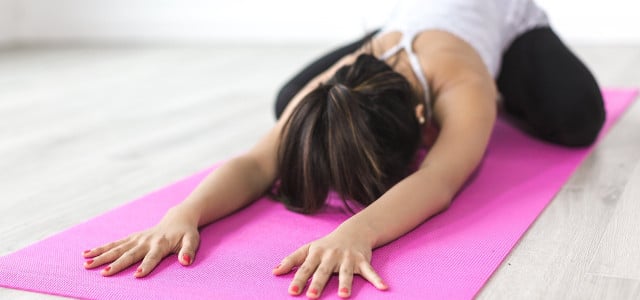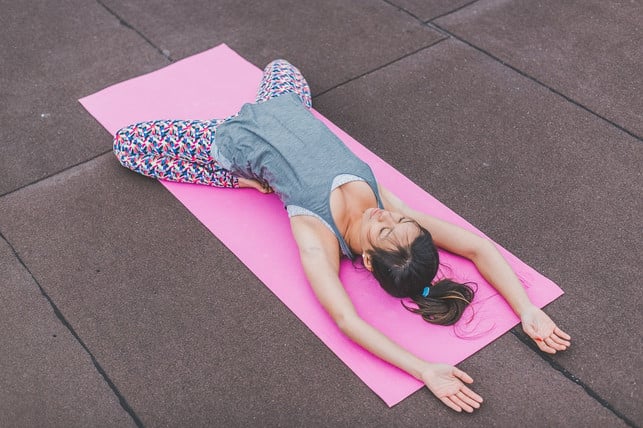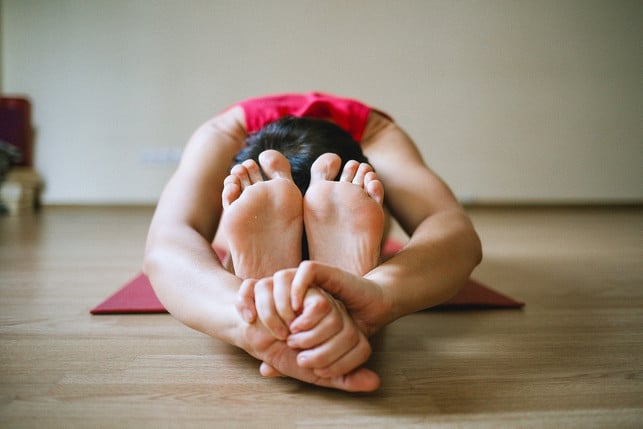
Yin Yoga is a slow yoga style in which the poses are kept for several minutes. You can stretch your connective tissue thoroughly and find a quiet mind. We introduce you to the style in detail.
The term “Yin Yoga” is derived from the Chinese concept of Yin and Yang, which plays a role, especially in Daoism. Yin and Yang describes this philosophy as opposite forces or principles: While Yin represents the female, calm, soft and passive energy, Yang embodies the male, hard, dynamic and active counterpart. In anatomical terms, Yang stands for the muscles and yin for connective tissue such as tendons and ligaments.
The Daoist yoga teacher Paulie Zink turned this principle into yoga for the first time in the late 1970s: with Yin Yoga, he developed a yoga style that compensates for the active, dynamic and physically exhausting yoga styles. The yoga teacher Paul Grilley and the yoga teacher Sarah Powers then shaped Yin Yoga further and mature to the style when he is known today.
Yin Yoga has always been characterized by a calm, slow practice in which the poses are kept for a long time. Basically, this is not a reinvention, but a crucial part of practices such as traditional Hatha yoga and Daoist yoga. For example, Poznan is kept in the iyengar yoga.
The practice in Yin Yoga: calm, passive, meditative

Yin Yoga is a quiet, passive yoga style, in which the asanas (postures) are largely lying and sitting and kept between three and seven minutes. A neutral lying position for harmonization is often often integrated between the asanas.
A typical Yin yoga lesson comprises prevent, light back, hip openers and rotations. Some of the asanas are also known from other yoga stils, for example the shoulder stand or the sun salutation. For differentiation, many poses in Yin Yoga have other names: the sprinter is called dragon, the pigeon instead swan.
This should prevent students from practicing the pose as they know them from other yoga styles. Because physically, the asanas look similar or the same, but the intention and the inner attitude is different: in Yin yoga, the poses are usually carried out with little to no muscle effort. Instead, all the muscles that are not required should be released completely, creating space for a quiet, meditative state.
In contrast to restorative yoga, Yin Yoga is less about relaxation than to stretch deeply connective tissue and muscles with gravity.
Often and ending yin yoga lessons with a short meditation. Sometimes sound shells are also used or the OM-MANTRA is spoken.
This is how Yin Yoga acts on body and mind

Since our fast -moving everyday life is often characterized by stress and most sports of tension, Chinese medicine and philosophy are according to many people that Yang is more present. Yin Yoga is intended to bring the opposite forces of Yin and Yang back into balance – on a physical and mental level.
On the physical level, the muscles, ligaments and tendons are stretched thoroughly. By keeping the asanas for a long time, the deep connective tissue is also reached and lured fascia loosen up and “torn up”. The concept of the fascia is called the connective tissue, which, like a large network, envelops all muscles, bones and organs and thus holds the body together.
Yin yoga helps against muscular tension and ensures more freedom of movement, more smooth joints and more flexible connective tissue and muscles. Unlike in other yoga styles in which the back is deliberately kept straight, it is always rounded in Yin Yoga. By stretching the back muscles, practice can therefore help with back pain.
On a psychological level, Yin Yoga looks like silent meditations: During the long -held posture, the mind comes to rest and you are increasingly drawing attention to you and your body. This should lead to a more balanced spirit and inner peace. Yin Yoga is therefore well suited to reduce stress and prevent its origin. According to a study from 2018, Yin Yoga was actually able to improve psychological health stressed adults. A study from 2021 also came to a similar result.
By counteracting Yin Yoga psychological problems such as anxiety, stress and depression, the yoga style is even suitable for preventing non-transferable diseases such as cardiovascular diseases, according to the 2018 study.
Yin Yoga: Who is the yoga style suitable for?

Yin Yoga is not only yoga for beginners: inside, but in principle suitable for everyone. If you have to deal with a full schedule, a hectic everyday life or tension, you can find the necessary compensation with regular yin yoga.
Yin Yoga is also particularly recommended for older people and for rehabilitation for diseases and accidents. If you have physical suffering such as a meniscal tear or a herniated disc, you should get medical advice in advance to see which posture is suitable for you.
If you already practice a different, more demanding yoga style such as Ashtanga yoga, jivamucti yoga or bikram yoga, an occasional Yin Yoga lesson can be a good complement. Yin Yoga can also be a suitable compensation for sports such as climbing, fitness training, handball or swimming. After training, for example, it is well suited for stretching.
Revised by Lea Hermann
Read more on utopia.de:
- Yoga accessories: You need that for training
- Yoga mats: These 8 are durable, sustainable, low in pollutants
- Yoga challenge: That happened when I made yoga every day
** marked with ** or orange underlined Links to sources of supply are partially partner links: If you buy here, you will actively support Techzle\.com, because we will then receive a small part of the sales proceeds. More information.